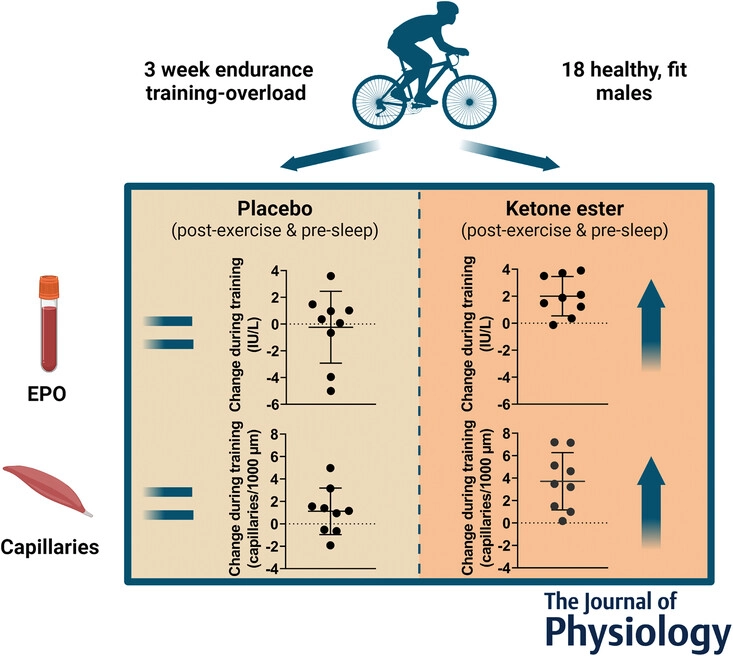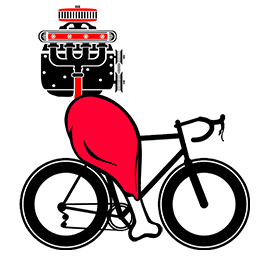Increased Capillaries , VEGF, eNOS and Potential Higher Oxygen Deliver and Waste Product Removal
A recent study found that ketone ester supplements may help cyclists improve performance by boosting their body’s ability to deliver oxygen to muscles during intense training. Researchers studied 18 healthy and fit male volunteers, including cyclists, over 3 weeks of endurance overload cycling – 10 training sessions per week. Half the volunteers consumed 25g of a ketone ester supplement after each ride and before bed. The other half consumed an equal-calorie placebo.
After 3 weeks, the ketone ester group increased the number of capillaries, the smallest blood vessels, contacting muscle fibers by 44% and the capillary-to-fiber perimeter exchange index, a measure of oxygen delivery, by 42%. The placebo group showed no such increases. More capillaries and greater oxygen exchange means muscles have access to more oxygen, which is vital for cycling performance.
The ketone ester group also had substantial increases in vascular endothelial growth factor (VEGF) and endothelial nitric oxide synthase (eNOS) in their leg muscles. VEGF stimulates new capillary growth while eNOS helps dilate existing capillaries to increase blood flow. For cyclists, more capillaries and better blood flow in leg muscles means faster delivery of oxygen and removal of waste products during cycling. This could boost power output and endurance.
The ketone ester group increased their blood erythropoietin (EPO) levels by 26% compared to placebo. EPO stimulates red blood cell production, which helps carry oxygen in the blood to muscles. For cyclists, higher EPO means more oxygen-carrying red blood cells to transport oxygen to hard-working leg muscles.
The results show that ketone ester supplements during intense cycling training may directly stimulate the growth of new capillaries in leg muscles. This could partly result from increased levels of VEGF, eNOS, and EPO triggered by the supplements. The supplements also appear to counter the normal inhibition of new capillary growth that results from excessive cycling training loads. For cyclists, the potential benefits of more capillaries and oxygen delivery are clear.
While this, like most exercise studies has a small sample group (N=18), it is interesting to note that every participant except one made gains on the ketone esters and none regressed like in the placebo group (see graphic below).
In summary, ketone ester supplements show promise for helping cyclists increase their performance during intense training periods. By stimulating new capillary growth and possibly boosting red blood cell counts, the supplements may enhance oxygen delivery to leg muscles when cycling loads are highest. Cyclists should consider adding ketone ester supplements to their nutritional strategies, especially during overload cycling blocks, to gain maximum benefits from their training. Further research is still needed, however, to confirm the potential long-term impacts on cycling performance.
But Yikes-This Amount of Ketones Costs A Small Fortune
These cyclists took 50g of exogenous ketones a day. For △G Ketone Performance, that equates to $56 a day in ketone ester product. For KE1, by KetoneAid that’s $46 per day. These are the only two companies making true Ketone Monoesters. Everything else is either salt-based or not a true ester bond of D- Beta Hydroxybutyrate and R 1,3 Butanediol. (For example, HVMN is not this.) Very few non-pro/non-sponsored athletes will be able to afford this amount of exogenous ketones daily.
An Aside
We are glad to see Ketone Ester testing progress past the “drink some ketones and then do a time trial” type studies. These longer-looking studies on the mechanisms necessary for successful endurance training and performance are welcomed. These Ketone Ester studies are looking more promising than the immediate impact studies.
Abstract
Exogenous ketosis elevates circulating erythropoietin and stimulates muscular angiogenesis during endurance training overload
De novo capillarization is a primary muscular adaptation to endurance exercise training and is crucial to improve performance. Excess training load, however, impedes such beneficial adaptations, yet we recently demonstrated that such downregulation may be counteracted by ketone ester ingestion (KE) post-exercise. Therefore, we investigated whether KE could increase pro-angiogenic factors and thereby stimulate muscular angiogenesis during a three-week endurance training-overload period involving 10 training sessions/week in healthy, male volunteers. Subjects received either 25g of a ketone ester (KE, n = 9) or a control drink (CON, n = 9) immediately after each training session and before sleep. In KE, but not in CON, the training intervention increased number of capillary contacts and capillary-to-fiber perimeter exchange index by 44% and 42%, respectively. Furthermore, KE also substantially increased VEGF and eNOS expression both at the protein and mRNA level. Serum erythropoietin concentration was concomitantly increased by 26%. Conversely, in CON the training intervention increased only the protein content of eNOS. These data indicate that intermittent exogenous ketosis during endurance overload training stimulates muscular angiogenesis. This likely resulted from a direct stimulation of muscle angiogenesis, which may be at least partly due to stimulation of erythropoietin secretion and elevated VEGF activity, and/or an inhibition of the suppressive effect of overload training on the normal angiogenic response to training. This study provides novel evidence to support the potential of exogenous ketosis to benefit endurance training-induced muscular adaptation.

KEY POINTS SUMMARY
- Increased capillarization is a primary muscular adaptation to endurance exercise training. However, excess training load may impede such response.
- We previously observed that intermittent exogenous ketosis by postexercise and pre-sleep ketone ester ingestion (KE) counteracted physiological dysregulations induced by endurance overload training. Therefore, we investigated whether KE could increase pro-angiogenic factors thereby stimulating muscular angiogenesis during a three-week endurance training-overload period.
- We show that the overload training period in the presence, but not in the absence of KE, markedly increased muscle capillarization (+40%).
- This increase was accompanied by higher circulating erythropoietin concentration and stimulation of the pro-angiogenic factors VEGF and eNOS in skeletal muscle.
- Collectively, our data indicate that intermittent exogenous ketosis may evolve as a potent nutritional strategy to facilitate recovery from strenuous endurance exercise, thereby stimulating beneficial muscular adaptations.
Abstract figure legend: Eighteen healthy, fit male volunteers were subjected to a 3 week endurance training-overload program. Subjects received either 25g of a ketone ester drink or an isocaloric placebo immediately after each training session and before sleep. The training intervention increased skeletal muscle capillarization in the ketone ester group, but not in the placebo group. The angiogenic response in the ketone ester group was accompanied by an increase in circulating erythropoietin (EPO) concentrations, and stimulation of pro-angiogenic factors in skeletal muscle. These findings indicate that intermittent ketone ester supplementation stimulates beneficial muscular adaptations during strenuous endurance exercise training.
The Journal of Physiology 16 April 2023
Authors: Chiel Poffé, Ruben Robberechts, Ruud Van Thienen, Peter Hespel
Sources: https://doi.org/10.1113/JP284346
https://physoc.onlinelibrary.wiley.com/doi/10.1113/JP284346?fbclid=IwAR1q8O0fJqvA7z-20qkBSA5lCp_ygHjGTDizqAZ5BAbERh_nve_NFe-JC_E
Listen to the Two Minute Audio Summary

Jordan Fowler has experience as a head swimming coach of the Frisco Swim Team, a TAAF-awarded coach, a track and field distance running consultant for select Texas High School runners, and has competed as a triathlete, road runner, and cyclist. Though he is remarkably slower than he was in his 20s and 30s, he still enjoys endurance sports and sports science studies.
